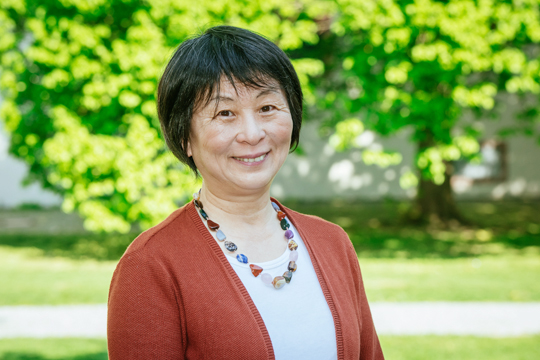Of tiny sparrows and just the right tone
Freiburg, Apr 26, 2018
More than 1.3 billion people speak Chinese worldwide – 955 million of which are native speakers. Chinese is considered one of the five world languages, but students seldom take a course in it at the Language Teaching Centre (SLI) at the University of Freiburg. Is it due to the level of difficulty? In a series on seldom-learned languages, Christine Hohlbaum talked to the Chinese lecturer Guo Li about the advantages and misunderstandings of the most spoken language in the world.

The Peking native Li Guo came to Freiburg to learn German in 1991. She has been teaching Chinese since 1995. She first started teaching at the Volkshochschule. Two years later she received a position at the University of Freiburg and has been teaching students the language ever since. Photo: Klaus Polkowski
Frau Guo, why is Chinese one of the seldom-learned languages?
Li Guo: It may be because people have a certain idea about the Chinese language. It seems strange to them because it is an image-based language. But in truth, Chinese characters consist of only five different types of strokes. A scholar may command 6,000 characters, a high school student about half. German has only 26 letters, but the possible composition of the letters is infinite. It is the same in Chinese.
What are some of the reasons to learn Chinese?
Language is a cultural medium. When you learn a foreign language, you not only acquire a new means of communication, but also skills to better understand the mentality of the country, acquiring it over time. For example, there is no “yes” or “no” in Chinese. An affirmation or negation is emphasized by one sentence: “Do you want to eat?” If you mean “yes,” you say “eat.” If you mean “no,” you say “do not eat.”
Which expression should everyone learn?
Standard words such as “Hello” (Nǐ hǎo), “Thank you” (xièxiè) or “Goodbye” (zàijiàn) are always good to have up your sleeve.
What is your favorite word?
“Peace” (héping) and “harmony” (hémù) are two of my favorite words. And there are two others: “freedom” (zìyóu) and “justice” (gōngzhèng).
What “false friend” should people watch for in Chinese?
Chinese is not only an image-based language, but a tonal one as well. The meaning of a word depends greatly on the emphasis you give it. For example, you say mā for “mother”, but má for “numb”. Mă means “horse” and mà means “to rant.” Adjectives and the context ensure that there are no misunderstandings.
Which Chinese expression do you miss in German?
The term yuánfèn is a great word. As a translator, I sometimes struggle with the exact equivalent in German. It means something like “divine providence”, but only as it relates to human relationships.
Which Chinese word best describes the University of Freiburg?
There is a Chinese saying: “The sparrow may be small, but it has everything.” (Máquè suī xiǎo wǔzàng jùquán). That is how I would describe the University. With 11 faculties and 18 academic centers, the University has a lot of offer. Students make up ten percent of the city’s population. That is a wonderful thing indeed.
Language Teaching Centre
The Language Teaching Centre (SLI) at the University of Freiburg offers courses in more than 20 languages that are open to all students, staff and University guests along with the general public.
Course offerings and registration

